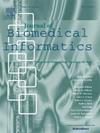Causal inference for time series datasets with partially overlapping variables
IF 4.5
2区 医学
Q2 COMPUTER SCIENCE, INTERDISCIPLINARY APPLICATIONS
引用次数: 0
Abstract
Objective:
Healthcare data provides a unique opportunity to learn causal relationships but the largest datasets, such as from hospitals or intensive care units, are often observational and do not standardize variables collected for all patients. Rather, the variables depend on a patient’s health status, treatment plan, and differences between providers. This poses major challenges for causal inference, which either must restrict analysis to patients with complete data (reducing power) or learn patient-specific models (making it difficult to generalize). While missing variables can lead to confounding, variables absent for one individual are often measured in another.
Methods:
We propose a novel method, called Causal Model Combination for Time Series (CMC-TS), to learn causal relationships from time series with partially overlapping variable sets. CMC-TS overcomes errors by specifically leveraging partial overlap between datasets (e.g., patients) to iteratively reconstruct missing variables and correct errors by reweighting inferences using shared information across datasets. We evaluated CMC-TS and compared it to the state of the art on both simulated data and real-world data from stroke patients admitted to a neurological intensive care unit.
Results:
On simulated data, CMC-TS had the fewest false discoveries and highest F1-score compared to baselines. On real data from stroke patients in a neurological intensive care unit, we found fewer implausible and more highly ranked plausible causes of a clinically important adverse event.
Conclusion:
Our approach may lead to better use of observational healthcare data for causal inference, by enabling causal inference from patient data with partially overlapping variable sets.

部分重叠变量时间序列数据集的因果推理
目的:医疗保健数据为了解因果关系提供了独特的机会,但最大的数据集(如来自医院或重症监护病房的数据集)通常是观察性的,不能对所有患者收集的变量进行标准化。相反,这些变量取决于病人的健康状况、治疗计划和提供者之间的差异。这对因果推理提出了重大挑战,因果推理要么必须将分析限制在具有完整数据的患者(降低了能力),要么必须学习特定于患者的模型(使其难以推广)。虽然缺少变量可能导致混淆,但一个个体缺少的变量通常会在另一个个体中测量。方法:我们提出了一种新的方法,称为时间序列因果模型组合(CMC-TS),从部分重叠变量集的时间序列中学习因果关系。CMC-TS通过特别利用数据集(例如,患者)之间的部分重叠来迭代地重建缺失变量,并通过使用跨数据集的共享信息重新加权推断来纠正错误,从而克服错误。我们对CMC-TS进行了评估,并将其与神经重症监护病房中风患者的模拟数据和真实数据进行了比较。结果:在模拟数据上,与基线相比,CMC-TS的错误发现最少,f1得分最高。在神经重症监护病房中风患者的真实数据中,我们发现较少的不可信原因和更多的高排名合理的临床重要不良事件的原因。结论:我们的方法可以从部分重叠变量集的患者数据中进行因果推断,从而更好地利用观察性医疗数据进行因果推断。
本文章由计算机程序翻译,如有差异,请以英文原文为准。
求助全文
约1分钟内获得全文
求助全文
来源期刊

Journal of Biomedical Informatics
医学-计算机:跨学科应用
CiteScore
8.90
自引率
6.70%
发文量
243
审稿时长
32 days
期刊介绍:
The Journal of Biomedical Informatics reflects a commitment to high-quality original research papers, reviews, and commentaries in the area of biomedical informatics methodology. Although we publish articles motivated by applications in the biomedical sciences (for example, clinical medicine, health care, population health, and translational bioinformatics), the journal emphasizes reports of new methodologies and techniques that have general applicability and that form the basis for the evolving science of biomedical informatics. Articles on medical devices; evaluations of implemented systems (including clinical trials of information technologies); or papers that provide insight into a biological process, a specific disease, or treatment options would generally be more suitable for publication in other venues. Papers on applications of signal processing and image analysis are often more suitable for biomedical engineering journals or other informatics journals, although we do publish papers that emphasize the information management and knowledge representation/modeling issues that arise in the storage and use of biological signals and images. System descriptions are welcome if they illustrate and substantiate the underlying methodology that is the principal focus of the report and an effort is made to address the generalizability and/or range of application of that methodology. Note also that, given the international nature of JBI, papers that deal with specific languages other than English, or with country-specific health systems or approaches, are acceptable for JBI only if they offer generalizable lessons that are relevant to the broad JBI readership, regardless of their country, language, culture, or health system.
 求助内容:
求助内容: 应助结果提醒方式:
应助结果提醒方式:


